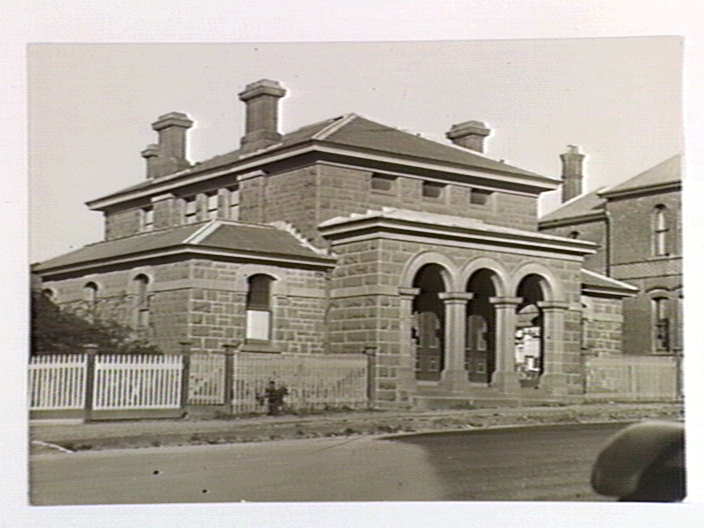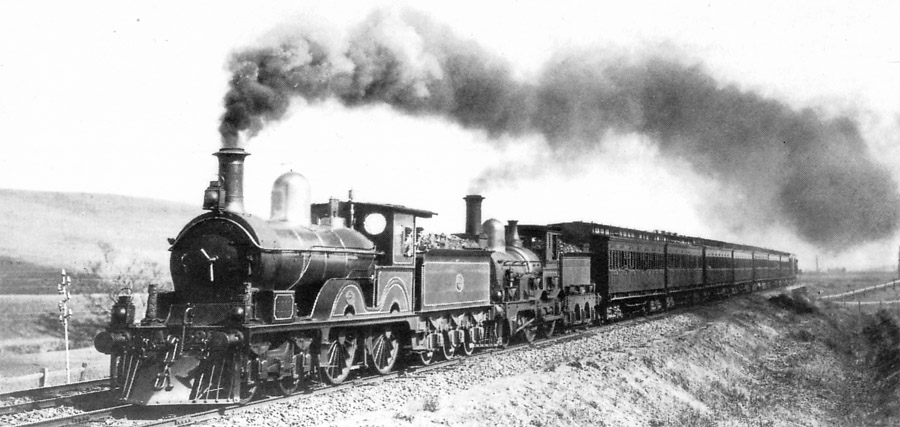|
Kilmore Railway Station
Kilmore railway station was a railway station servicing the town of Kilmore, Victoria, Australia. It was located on Rutledge Street, Kilmore, to the east of Assumption College. It opened on 1 October 1888 along with the first section of the Heathcote branch line. The town had previously been served by a Kilmore station east of the town on the main North East railway line, which was renamed Kilmore East railway station upon its opening. The station was serviced by the Bylands Railway Reservoir. The local council pressed for the construction of refreshment rooms in 1889, and these were in operation by 1896. There was a train accident at the station in 1892 and a benzene explosion there in 1903. It was the junction station for the short-lived Lancefield railway line The Lancefield railway line, or the Clarkefield and Lancefield Railway, was a former broad gauge railway in central Victoria, connecting Clarkefield railway station on the Bendigo line to Kilmore railway st ... [...More Info...] [...Related Items...] OR: [Wikipedia] [Google] [Baidu] |
Kilmore, Victoria
Kilmore () is a town in the Australian state of Victoria. Located north of Melbourne, it is the oldest inland town in Victoria by the combination of age and physical occupation, and because it had unique agricultural attributes to drive that earliest settlement. It grew very rapidly to become four times bigger than its nearest inland rival by 1851. Its spectacular growth continued to match that of the major gold mining towns of Ballarat, Bendigo and Beechworth until at least 1861. History The traditional owners of Kilmore and the Kilmore Plains are the Taungurung people, a part of the Kulin nation that inhabited a large portion of central Victoria including Port Phillip Bay and its surrounds. The Tommy McRae artwork held by the National Gallery of Australia depicts the "Kilmore Tribe Holding Corobboree", and a child pioneer of Kilmore, James Hamilton, describes in detail just such a corroboree at Kilmore in 1845. The area was known to the Taungurung as ''Mumillinuck''. Kilmor ... [...More Info...] [...Related Items...] OR: [Wikipedia] [Google] [Baidu] |
Australia
Australia, officially the Commonwealth of Australia, is a Sovereign state, sovereign country comprising the mainland of the Australia (continent), Australian continent, the island of Tasmania, and numerous List of islands of Australia, smaller islands. With an area of , Australia is the largest country by area in Oceania and the world's List of countries and dependencies by area, sixth-largest country. Australia is the oldest, flattest, and driest inhabited continent, with the least fertile soils. It is a Megadiverse countries, megadiverse country, and its size gives it a wide variety of landscapes and climates, with Deserts of Australia, deserts in the centre, tropical Forests of Australia, rainforests in the north-east, and List of mountains in Australia, mountain ranges in the south-east. The ancestors of Aboriginal Australians began arriving from south east Asia approximately Early human migrations#Nearby Oceania, 65,000 years ago, during the Last Glacial Period, last i ... [...More Info...] [...Related Items...] OR: [Wikipedia] [Google] [Baidu] |
Assumption College (Worcester)
Assumption University is a private, Roman Catholic university in Worcester, Massachusetts. Assumption was founded in 1904 by the Augustinians of the Assumption. It enrolls about 2,000 undergraduate students"Profile: Assumption College" U.S. News & World Report, College Rankings and offers 35 majors and 49 minors. The university confers and degrees in its undergradu ... [...More Info...] [...Related Items...] OR: [Wikipedia] [Google] [Baidu] |
Heathcote Railway Line
The Heathcote Railway line was a railway line linking Bendigo and Heathcote Junction. It was opened in 1888, and, by 1890 it was fully operational.Wallan - Bendigo Victorian Railways Grades Book It was partially closed in 1958 and fully closed in 1968. In 1975 it was chosen to dismantle the railway line and today, only several trestle bridges remain. History The line was authorised in 1881, and construction began in 1888. The first section between Kilmore, Victoria, Kilmore and Bendigo opened in 1888, and the entire line was operational in 1890. This line, including 50 bridges, took 21 months to complete at a cost of 88,409 Pound sterling, pounds, and two derailments in the process.[...More Info...] [...Related Items...] OR: [Wikipedia] [Google] [Baidu] |
Kilmore Free Press
Kilmore may refer to: Places Australia *Electoral district of Kilmore, Victoria *Kilmore, Victoria, Australia, a town *Shire of Kilmore, a local government area north of Melbourne Ireland *Kilmore, County Cavan, a parish *Kilmore, County Wexford, a village *Kilmore, Dublin, a suburb *Kilmore Quay, County Wexford, a fishing village Northern Ireland * Kilmore, County Antrim, a townland in County Antrim *Kilmore, County Armagh, a village and townland in County Armagh *Kilmore, County Down, a village, parish and townland Other places *Kilmore, Skye, Scotland *Kilmore, Indiana, United States People *Chris Kilmore (born 1973), American musician and DJ *Kevin Kilmore (born 1959), English footballer Other uses *Bishop of Kilmore *Diocese of Kilmore (other) See also * Kilmore East, Victoria, Australia * Kilmore West Kilmore West () is a locality within Dublin 5, situated on Dublin's Northside, Ireland. Located in the Dublin 5 district, it borders Santry, Beaumont, ... [...More Info...] [...Related Items...] OR: [Wikipedia] [Google] [Baidu] |
North East Railway Line
The North East railway line is a railway line in Victoria, Australia. The line runs from Albury railway station in the border settlement of Albury–Wodonga to Southern Cross railway station on the western edge of the Melbourne central business district, serving the cities of Wangaratta and Seymour, and smaller towns in northeastern Victoria. The line is owned by VicTrack, but leased to, and maintained by, the Australian Rail Track Corporation, and forms part of the Sydney–Melbourne rail corridor. Unlike most other heavy rail lines in Victoria, the line is completely standard gauge, after works were carried out between 2008 and 2010. However, the broad gauge Tocumwal line runs parallel to the line between Seymour and Broadmeadows. History The Melbourne and Essendon Railway Company opened the first section of the Albury line, from North Melbourne to Essendon, in 1860. Following its takeover by the Victorian Government in 1867, the line was extended by 1872 to S ... [...More Info...] [...Related Items...] OR: [Wikipedia] [Google] [Baidu] |
Kilmore East Railway Station
Kilmore East railway station is located on the North East line in Victoria, Australia. It serves the town of Kilmore East, and opened on 18 April 1872 as Kilmore. It was renamed Kilmore East on 1 October 1888.Kilmore East Vicsig The town of Kilmore is some distance to the west, at a much higher elevation, and was unable to be served directly by the main-line railway. There is a disused at the station, as well as a staffed signal box. [...More Info...] [...Related Items...] OR: [Wikipedia] [Google] [Baidu] |
The Argus (Melbourne)
''The Argus'' was an Australian daily morning newspaper in Melbourne from 2 June 1846 to 19 January 1957, and was considered to be the general Australian newspaper of record for this period. Widely known as a conservative newspaper for most of its history, it adopted a left-leaning approach from 1949. ''The Argus''s main competitor was David Syme's more liberal-minded newspaper, ''The Age''. History The newspaper was originally owned by William Kerr, who was also Melbourne's town clerk from 1851–1856 and had been a journalist at the ''Sydney Gazette'' before moving to Melbourne in 1839 to work on John Pascoe Fawkner's newspaper, the '' Port Phillip Patriot''. The first edition was published on 2 June 1846. The paper soon became known for its scurrilous abuse and sarcasm, and by 1853, after he had lost a series of libel lawsuits, Kerr was forced to sell the paper's ownership to avoid financial ruin. The paper was then published by Edward Wilson. By 1855, it had a daily c ... [...More Info...] [...Related Items...] OR: [Wikipedia] [Google] [Baidu] |
The Herald (Melbourne)
''The Herald'' was a morning and, later, evening broadsheet newspaper published in Melbourne, Australia, from 3 January 1840 to 5 October 1990, which is when it merged with its sister morning newspaper ''The Sun News-Pictorial'' to form the ''Herald-Sun''. Founding The ''Port Phillip Herald'' was first published as a semi-weekly newspaper on 3 January 1840 from a weatherboard shack in Collins Street. It was the fourth newspaper to start in Melbourne. The paper took its name from the region it served. Until its establishment as a separate colony in 1851, the area now known as Victoria was a part of New South Wales and it was generally referred to as the Port Phillip district. Preceding it was the short-lived ''Melbourne Advertiser'' which John Pascoe Fawkner first produced on 1 January 1838 as hand-written editions for 10 weeks and then printed for a further 17 weekly issues, the ''Port Phillip Gazette'' and ''The Port Phillip Patriot and Melbourne Advertiser''. But within ei ... [...More Info...] [...Related Items...] OR: [Wikipedia] [Google] [Baidu] |
Lancefield Railway Line
The Lancefield railway line, or the Clarkefield and Lancefield Railway, was a former broad gauge railway in central Victoria, connecting Clarkefield railway station on the Bendigo line to Kilmore railway station on the Heathcote line, via Lancefield. However, the ill-fated Lancefield-Kilmore section operated only briefly in the 1890s so, for much of its history, the line existed simply as a branch line, with its terminus at Lancefield station. History Clarkefield-Lancefield section The branch line off the Melbourne-Bendigo line originated at Clarkefield, then known as Lancefield Junction, and ran to Bolinda, Monegeetta, North Monegeetta, Romsey and Lancefield, and was opened on 6 June 1881. The Lancefield-Clarkefield section of the branch was closed on 13 August 1956, when the wooden trestle bridge near Clarkefield required extensive maintenance and repairs. Though the railway right of way no longer exists, the former track bed can still be seen in many places, mos ... [...More Info...] [...Related Items...] OR: [Wikipedia] [Google] [Baidu] |
Clarkefield Railway Station
Clarkefield railway station is located on the Deniliquin line in Victoria, Australia. It serves the town of Clarkefield, and it opened in December 1862 as Lancefield Road. It was renamed Lancefield Junction in 1881, renamed Clarkfield on 11 January 1926, and renamed Clarkefield on 23 February 1926.Clarkefield VicsigClarkefield VR History History Clarkefield opened in December 1862, a year after the line opened between Sunbury and[...More Info...] [...Related Items...] OR: [Wikipedia] [Google] [Baidu] |
The Age
''The Age'' is a daily newspaper in Melbourne, Australia, that has been published since 1854. Owned and published by Nine Entertainment, ''The Age'' primarily serves Victoria (Australia), Victoria, but copies also sell in Tasmania, the Australian Capital Territory and border regions of South Australia and southern New South Wales. It is delivered both in print and digital formats. The newspaper shares some articles with its sister newspaper ''The Sydney Morning Herald''. ''The Age'' is considered a newspaper of record for Australia, and has variously been known for its investigative reporting, with its journalists having won dozens of Walkley Awards, Australia's most prestigious journalism prize. , ''The Age'' had a monthly readership of 5.321 million. History Foundation ''The Age'' was founded by three Melbourne businessmen: brothers John and Henry Cooke (who had arrived from New Zealand in the 1840s) and Walter Powell. The first edition appeared on 17 October 1854. ... [...More Info...] [...Related Items...] OR: [Wikipedia] [Google] [Baidu] |



.jpg)
